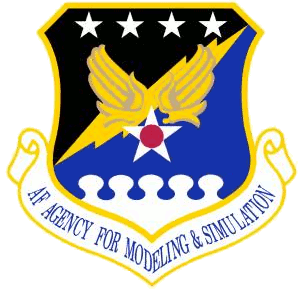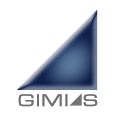Related Research Articles
The High Level Architecture (HLA) is a standard for distributed simulation, used when building a simulation for a larger purpose by combining (federating) several simulations. The standard was developed in the 1990s under the leadership of the US Department of Defense and was later transitioned to become an open international IEEE standard. It is a recommended standard within NATO through STANAG 4603. Today the HLA is used in a number of domains including defense and security and civilian applications.
Distributed Interactive Simulation (DIS) is an IEEE standard for conducting real-time platform-level wargaming across multiple host computers and is used worldwide, especially by military organizations but also by other agencies such as those involved in space exploration and medicine.

The United States Air Force established the Air Force Agency for Modeling and Simulation (AFAMS) in June 1996 at Orlando, Florida. AFAMS mission is to enhance and leverage Modeling & Simulation to support and facilitate integrated, realistic and efficient operational training across warfighting domains to enable full-spectrum readiness. AFAMS vision is advance readiness through Live, Virtual and Constructive (LVC) training.
SIMNET was a wide area network with vehicle simulators and displays for real-time distributed combat simulation: tanks, helicopters and airplanes in a virtual battlefield. SIMNET was developed for and used by the United States military. SIMNET development began in the mid-1980s, was fielded starting in 1987, and was used for training until successor programs came online well into the 1990s.

Delta3d is an open source software gaming/simulation engine API. Delta3d is managed and supported by Caper Holdings LLC. Previously the Modeling, Virtual Environments, and Simulation (MOVES) Institute at the Naval Postgraduate School in Monterey, California managed and supported delta3d. Alion Science has also been a major contributor to enhancements and features.
Web-based simulation (WBS) is the invocation of computer simulation services over the World Wide Web, specifically through a web browser. Increasingly, the web is being looked upon as an environment for providing modeling and simulation applications, and as such, is an emerging area of investigation within the simulation community.
A dynamic terrain is the representation of terrain together with the capability for modification during a simulation.
The Simulation Interoperability Standards Organization (SISO) is an organization dedicated to the promotion of modeling and simulation interoperability and reuse for the benefit of diverse modeling and simulation communities, including developers, procurers, and users, worldwide.
The Interservice/Industry Training, Simulation and Education Conference (I/ITSEC) is an annual conference in Orlando, Florida organized by the National Training and Simulation Association, an affiliate organization of the National Defense Industrial Association (NDIA) held at the Orange County Convention Center, a large conference and exhibition centre located on Exhibition Drive on the south side of Orlando, Florida.
Live, Virtual, & Constructive (LVC) Simulation is a broadly used taxonomy for classifying Modeling and Simulation (M&S). However, categorizing a simulation as a live, virtual, or constructive environment is problematic since there is no clear division among these categories. The degree of human participation in a simulation is infinitely variable, as is the degree of equipment realism. The categorization of simulations also lacks a category for simulated people working real equipment.
Mounted Warfare TestBed (MWTB) at Fort Knox, Kentucky, was the premier site for distributed simulation experiments in the US Army for over 20 years. It used simulation systems, including fully manned virtual simulators and computer-generated forces, to perform experiments that examined current and future weapon systems, concepts, and tactics.

GIMIAS is a workflow-oriented environment focused on biomedical image computing and simulation. The open-source framework is extensible through plug-ins and is focused on building research and clinical software prototypes. Gimias has been used to develop clinical prototypes in the fields of cardiac imaging and simulation, angiography imaging and simulation, and neurology
The virtual world framework (VWF) is a means to connect robust 3D, immersive, entities with other entities, virtual worlds, content and users via web browsers. It provides the ability for client-server programs to be delivered in a lightweight manner via web browsers, and provides synchronization for multiple users to interact with common objects and environments. For example, using VWF, a developer can take video lesson plans, component objects and avatars and successfully insert them into an existing virtual or created landscape, interacting with the native objects and users via a VWF interface.
The Joint Theater Level Simulation (JTLS) is used to simulate joint, combined, and coalition civil-military operations at the operational level. Used for civil/military simulations and humanitarian assistance/disaster relief (HA/DR) scenarios, JTLS is an interactive, computer-assisted simulation that models multi-sided air, ground, and naval resources with logistical Special Operation Forces (SOF) and intelligence support. The primary purpose of JTLS is to create a realistic environment in which agency staff can operate as they would within a real-world or operational situation.also information.A training audience conducts a scenario or event to practice their ability to coordinate various staff functions.
The Standard Interface for Multiple Platform Link Evaluation (SIMPLE) is a military communications protocol defined in NATO's Standardization Agreement STANAG 5602.
Distributed Simulation Engineering and Execution Process (DSEEP) is a standardized process for building federations of computer simulations. DSEEP is maintained by SISO and the standard is published as IEEE Std 1730-2010. DSEEP is a recommended systems engineering process in the NATO Modelling and Simulation Standards Profile AMSP-01, which also uses DSEEP as a framework for describing when other standards are to be used throughout a project process.
The Real-time Platform Reference Federation Object Model enables linking computer simulations of discrete physical entities into complex virtual worlds. It is a High Level Architecture (HLA) federation object model developed for distributed simulation applications of defense and security. RPR FOM is listed in the NATO Modelling and Simulation Standards Profile AMSP-01.
Katherine Lee Morse is an American computer scientist whose work has centered on distributed simulation, on the integration of heterogenous simulation environments, and on standardization of methods for interoperability in simulation, including participating in the development of the High Level Architecture for modeling and simulation. She is a member of the principal professional staff at the Johns Hopkins University Applied Physics Laboratory.
References
- ↑ "RPR FOM Interim Meeting". Simulation Interoperability Standards Organization, July 12, 2013.
- ↑ "WebLVC Linking Web-based Applications with Traditional M&S Federations". Simulation Interoperability Standards Organization, February 24, 2014.
- ↑ "WebLVC Final Report". Simulation Interoperability Standards Organization, February 11, 2014.
- ↑ "DI-Guy is Now Part of VT MAK". Military Simulation and Training Magazine, December 11, 2013.
- ↑ "Interactive Networked Battlefield Simulation Training Technologies" (PDF). Retrieved 20 May 2014.
- ↑ "WEB LIVE, VIRTUAL, CONSTRUCTIVE (WEBLVC) Study Group" . Retrieved 2 April 2014.
- ↑ "Rheinmetall Canada Chooses VT MAK'S Simulation and Visualization Components". Aerospace and Defense News. Retrieved 20 May 2014.
- ↑ "QuickStrike: An Air Force Operations Staff Trainer" (PDF). Air Force SBIR/STTR, September 11, 2009. 19 June 2020.
- ↑ "Pakistan Air Force Selects MAK ONE Software for Composite Simulation Centre's Synthetic Battlefield Environment". Global Defense Insight . 23 October 2022.
- ↑ "MAK ONE For Pakistan Air Force". Pakistan Strategic. 25 October 2022.
- ↑ "VT MÄK Expanding Applications to Civil Aviation". Inside S&T - Airline, August 10, 2011.
- ↑ "VT MÄK Expanding Applications to Civil Aviation". Halldale Group. Retrieved 20 May 2014.
- ↑ "MAK demonstrates HLA Evolved, DDS Interoperability..." 12 News. Retrieved 20 May 2014.
- ↑ Vats, Garima; Singh, Avantika; Chandra, Nidhi (2013). "Distributed Interactive Simulation and Its Application in Multi Sensor Tracking" (PDF). International Journal of Advanced Research in Computer Science and Software Engineering. 3 (4): 274–279. ISSN 2277-128X.